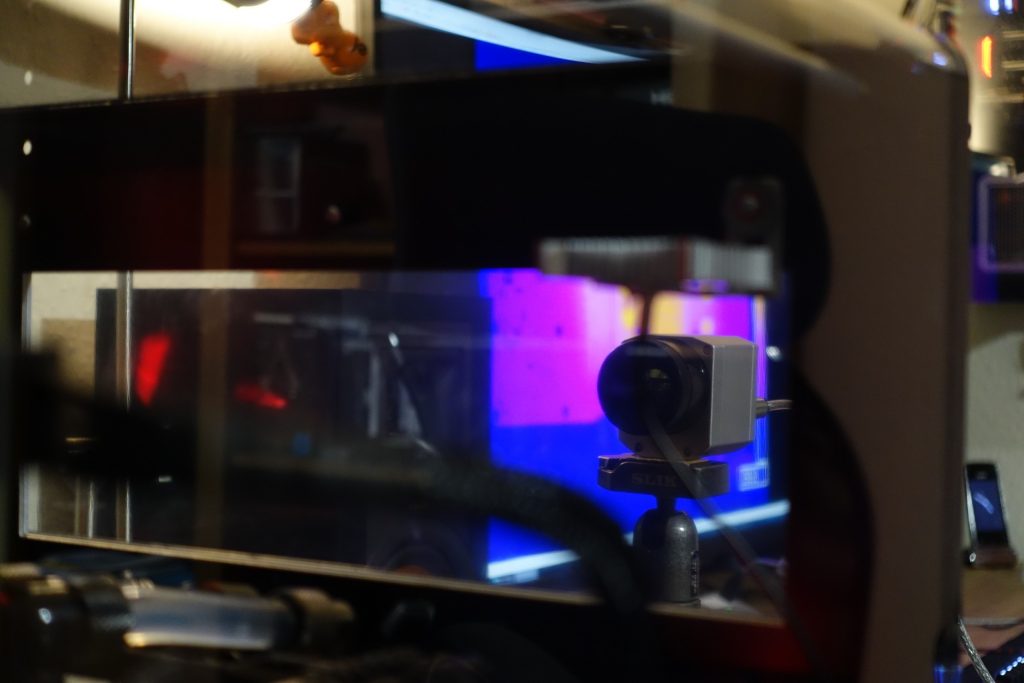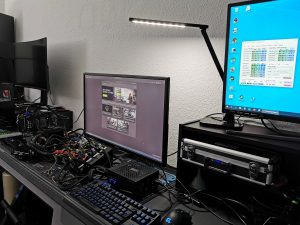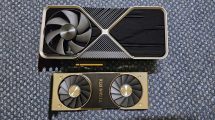Test setup
I already wrote that the test system had to be changed because I ran out of time. Hence the change to a still existing Intel system with a Core i9-13900K overclocked to 6 GHz, 32 GB RAM (2x 16 GB) in the form of the Corsair Dominator Platinum DDR5 6400 (XMP profile active) on an MSI MEG Z690 Unify. Two 2TB NVMe SSDs from Corsair and MSI are used, as well as an AiO compact water cooling system based on the Alphacool Eisbär Pro for the CPU.
I have been using an Optris Pi640 for the heat flow analyses and infrared images / radiometric videos for the non-contact measurements for years and because I had to change the system, I am using the “old” T70 benchtable from Lian Li again (picture above with special foil and cover), which I can also close like a PC case. The Pi640 is an industrial camera with interchangeable lenses, various additional parts and functional software. With a whopping 640 x 480 measuring pixels, the bolometer for capturing thermal radiation is already as large as a normal VGA camera, which is interpolated into the image for optical enhancement in many cheaper devices. Not much more is currently possible. The videos are recorded at up to 30 FPS (Hz), which is also in a class of its own.
The Keyence VHX-7000 system with coupled AE-300 from my own laboratory is a versatile 3D profilometer and the powerful microscope (max. x2000) with HDR function, automated lighting scenarios and huge depth of field can also be used perfectly for such examinations. It can also be used for material analysis, for which I don’t have to use an expensive SEM EDX. Vacuum? I no longer need it and it saves a lot of time. As long as you know what you’re getting into and what the limits of the method you’re using are, it works really well. That’s exactly what we need today.
However, the measurement of detailed power consumption and other, more in-depth things is carried out in the lab using two methods: high-resolution oscilloscope technology and the self-created, MCU-based measurement setup for motherboards and graphics cards (pictures below) or NVIDIA’s PCAT. Of course, I use a redundant system with the same components because such measurements are rather difficult in the case.
The audio measurements are carried out outside in my chamber (room within a room).
- 1 - Introduction, technical data and technology
- 2 - Test system and measuring equipment
- 3 - Teardown: Disassembling and cooler
- 4 - Teardown: PCB and components
- 5 - Teardown: Material analysis
- 6 - Gaming Performance FHD (1920 x 1080)
- 7 - Gaming-Performance WQHD (2560 x 1440)
- 8 - Gaming Performance Ultra-HD (3840 x 2160)
- 9 - Gaming Performance DLSS & FSR
- 10 - Power consumption and load balancing
- 11 - Transients, capping and PSU recommendation
- 12 - Temperatures, clock rate and tehrmal imaging
- 13 - Fan curves, noise and audio samples
- 14 - Summary and conclusion







































64 Antworten
Kommentar
Lade neue Kommentare
Urgestein
Veteran
Urgestein
Urgestein
Urgestein
Urgestein
Urgestein
Urgestein
Urgestein
Urgestein
Urgestein
Urgestein
Urgestein
Veteran
Mitglied
Alle Kommentare lesen unter igor´sLAB Community →